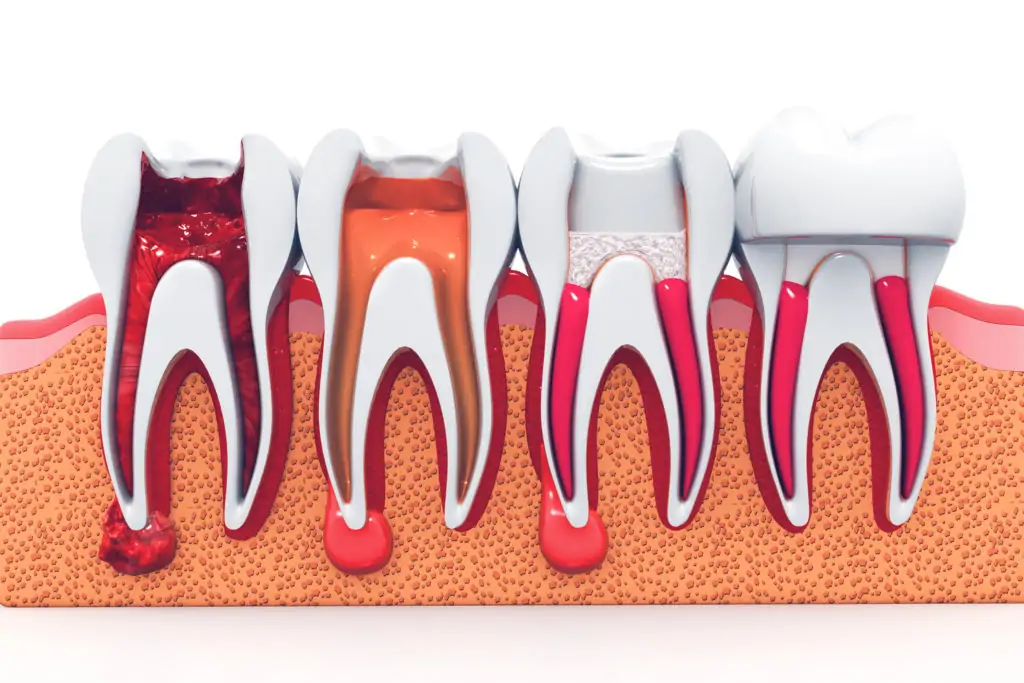A tooth is made up of enamel, dentin and pulp tissue. The enamel is the hardest outer covering of the tooth, the dentin is underneath the enamel. It is softer than the enamel and has a cushion-like effect. The pulp cavity is located in the central core of the tooth and has small hair like strands of the pulp tissue. This is composed of blood vessels and nerves which provide the nutrition and sensation to the tooth.
When food particles get stuck on the teeth, the bacteria in the mouth act on then to produce bacteria. This produces a mild acid which attacks the tooth and eats away the calcium of the tooth. This results in a brownish-black cavity on the tooth which is called dental caries. Dental caries if left untreated results in the cavity getting bigger and deeper resulting in discomfort, pain, infection, and swelling
Below, we will discuss About Root Canal Treatment Benefits, Procedures, And Costs, so that you will be having idea to choosing best dental clinic near you.
What is a root canal treatment?
When dental caries goes deeper and wider, it involves the dental pulp. As the dental pulp cavity contains the blood vessels and the nerves, this results in severe pain. The root canal treatment involves steps taken to clean the cavity as well as remove the infection in the pulp cavity. After the clean up the root canal, the cavity is filled up.
Root Canal Treatment Benefits:
Root canal treatment is done as a last line of treatment to save the tooth. When a cavity is small and involving the enamel or dentin a simple filling is good enough in most cases. However, when the cavity involves the pulp a simple filling cannot be done. It is in these cases that a root canal is treatment is done.
Doing a root canal treatment results in saving the tooth from extraction. The individual can function normally with a root canal treated tooth like a normal tooth. In cases where the root canal treatment is not done or delayed, it may result in a fracture of the tooth or severe infection and swelling. In such instances, the dentist will have no other option than to extract the tooth.
The procedure of root canal treatment
The first step in root canal treatment is the assessment of the tooth with a clinical diagnosis and radiographs. Local anaesthesia is used to numb the tooth. In the case of multiple root canals or very apprehensive patients, intravenous sedation or general anaesthesia is used, http://www.papsociety.org/ambien-zolpidem-10-mg/.
The dental caries is then removed completely using a high-speed handpiece and burs. Straight-line access is then prepared to help in locating the root canal or pulp cavity. The root canals are then located with the help of special instruments called files. The pulp cavity is then cleaned and shaped with the help of files and sequentially widened. This helps to remove all the infections as well as prepare the pulp cavity for the final filling.
During this procedure, the root cavity is irrigated with saline and other solutions. The root canal is then filled with a rubber-like material called gutta-percha. Once filled up, the gutta-percha is heat-sealed to avoid any leakage. The rest of the teeth are then filled up with a resin core. In some cases where there is moderate to severe damage to the tooth structure, a post is placed to hold the core material. The is now ready to receive the crown.
Is a crown necessary after root canal treatment?
A root canal treated tooth lacks the sensory biofeedback of a natural tooth. The root also has some level of dehydration and damage due to the treatment and cavity formation. In order to protect the tooth from further damage and to ensure proper function a crown is necessary in most cases. The crown process involves preparing the tooth, taking the measurement and fixing the crown. The types of crowns used are metal-ceramic crowns, zirconia crowns or lithium silicate crowns. The metal-free crowns are preferred for the front teeth as they are more cosmetic.

How long does it take to do and recover from root canal treatment?
The time to do a root canal and recover after a root canal is dependent on factors like severity of infection, the anatomy of the root canal, periapical lesion etc. While in most cases the root canal treatment is finished in a couple of days with postoperative healing being very good almost immediately. However, infection and convoluted anatomy of the root canal can result in multiple visits to complete the root canal. Postoperative healing may also be delayed in these situations.
Cost of root canal treatment in India
The cost of a root canal is dependent on the number of visits taken, the severity of infection, the types of materials used, the types of instruments used and the doctor’s expertise. In most metro cities the cost varies between 3000 Indian Rupees to 7000 Indian Rupees per tooth. Additional use of laser or microscope etc. can result in root canal treatment costing above 10,000 Indian Rupees.
So hope now you have the better idea about Root Canal Treatment Benefits, Procedures, and its cost.
